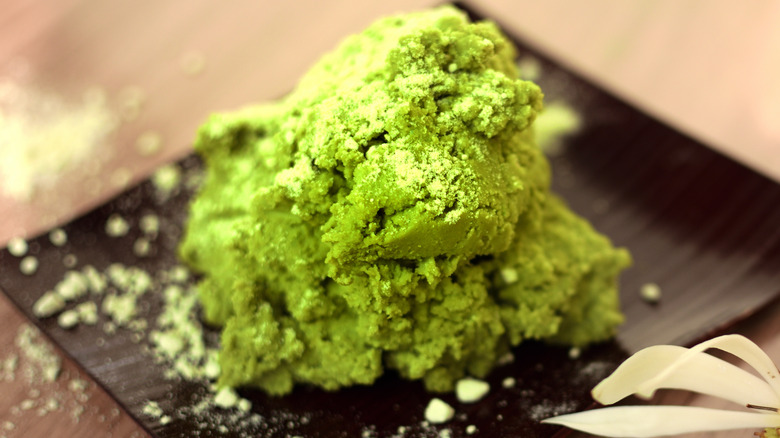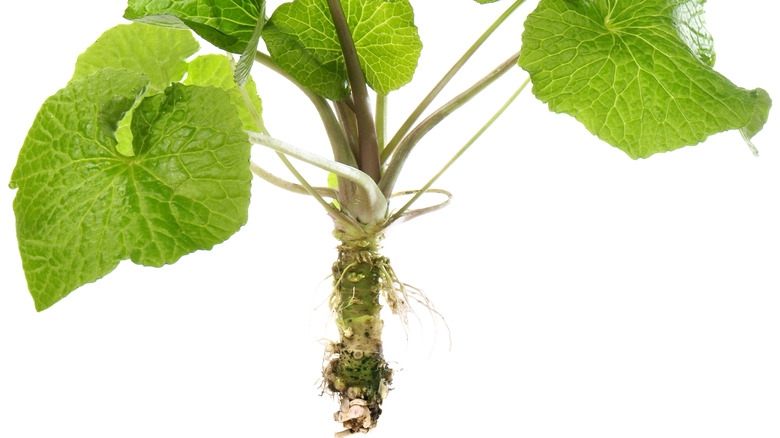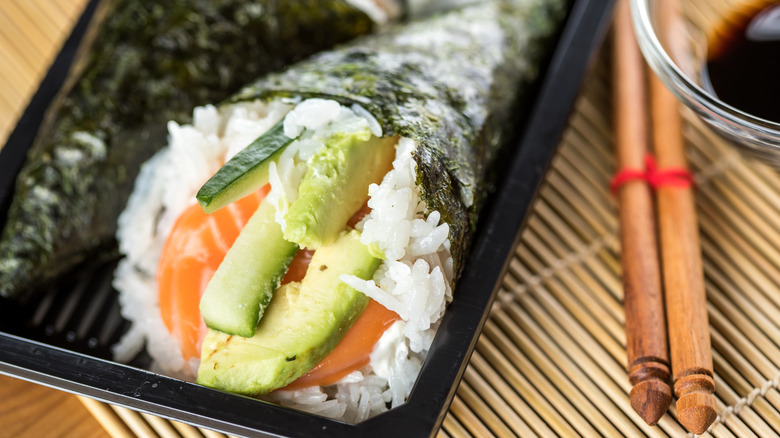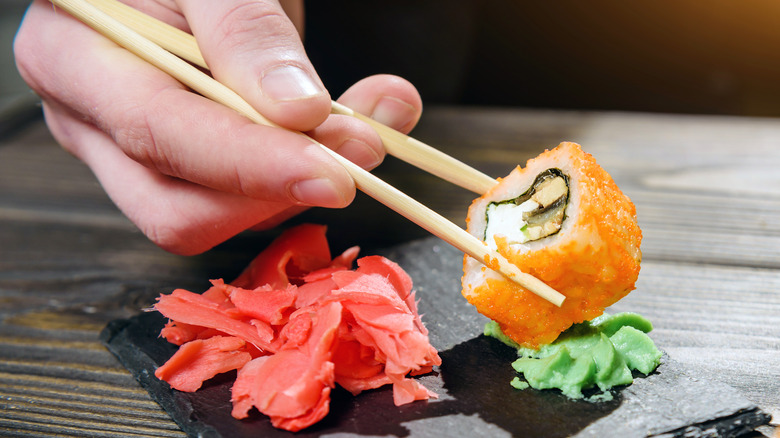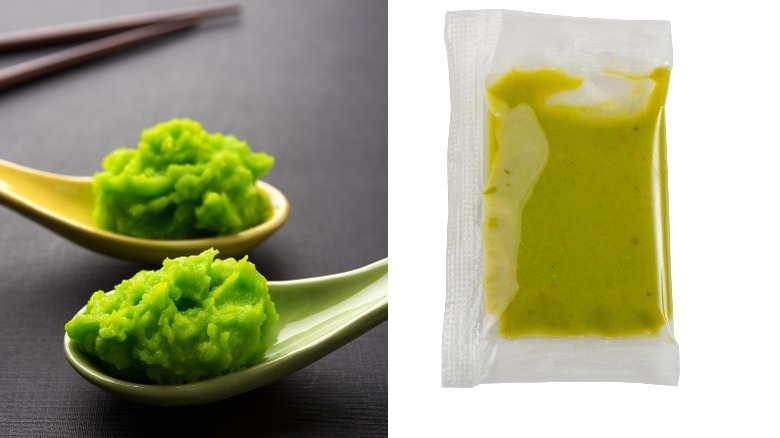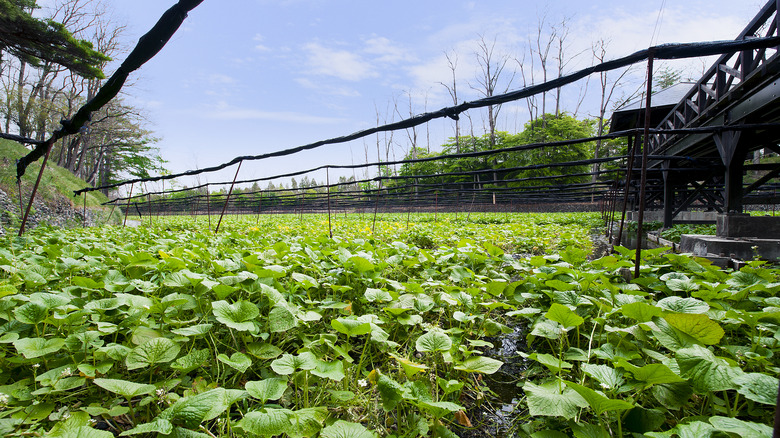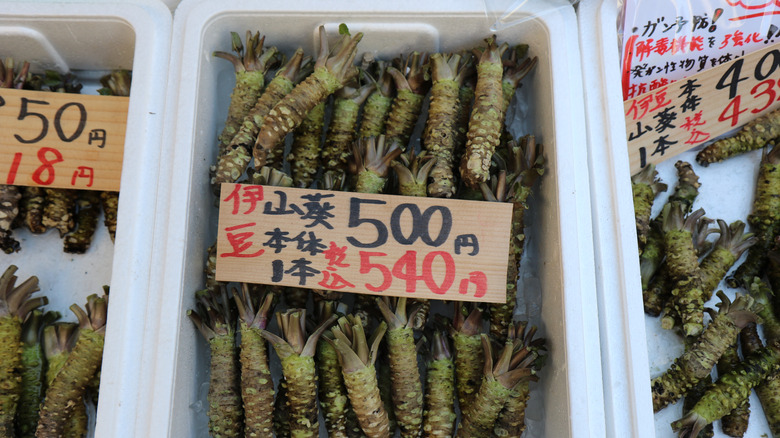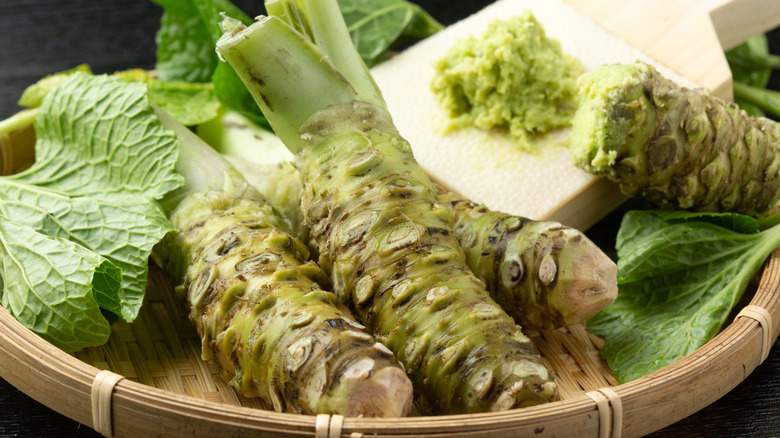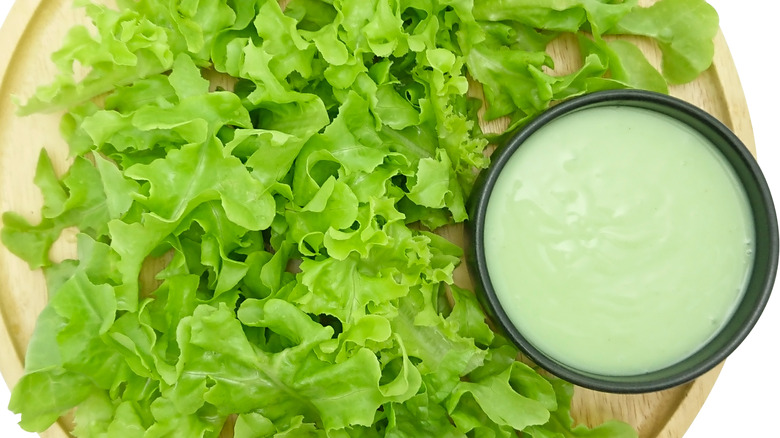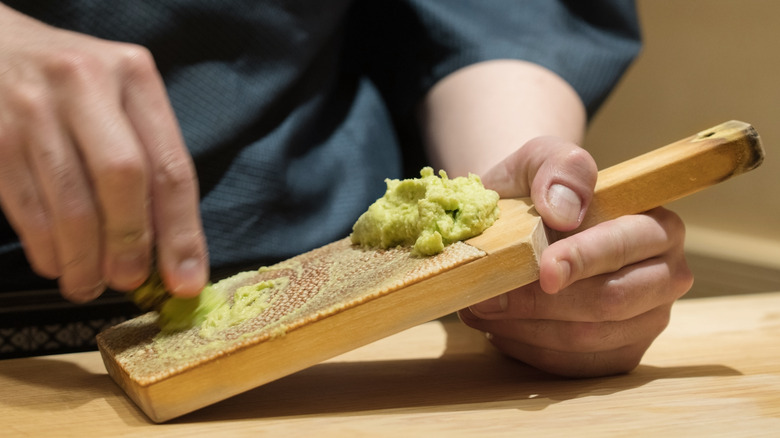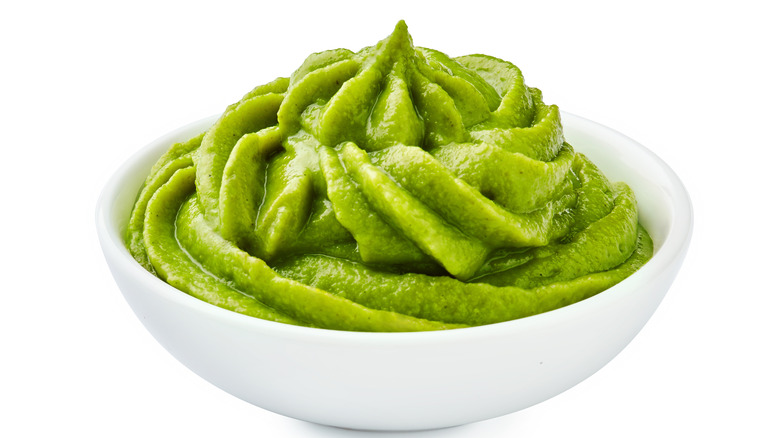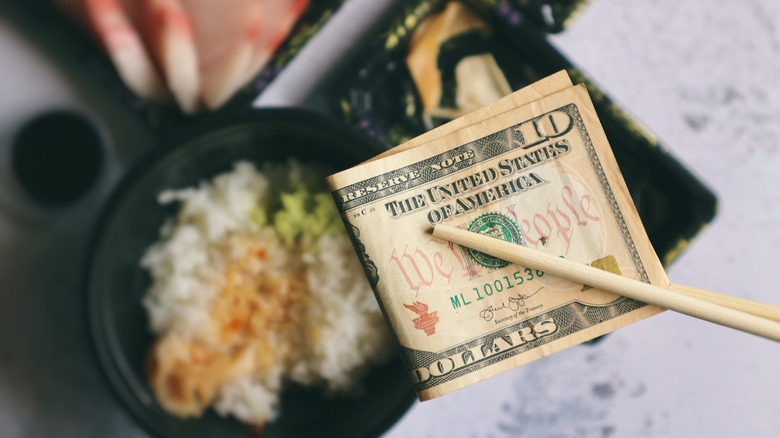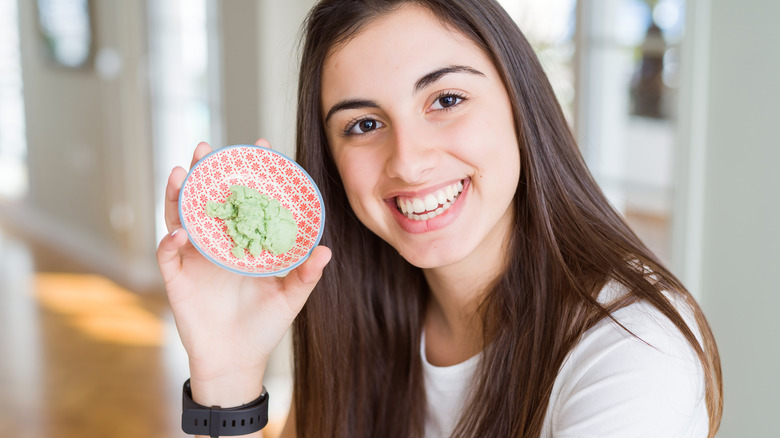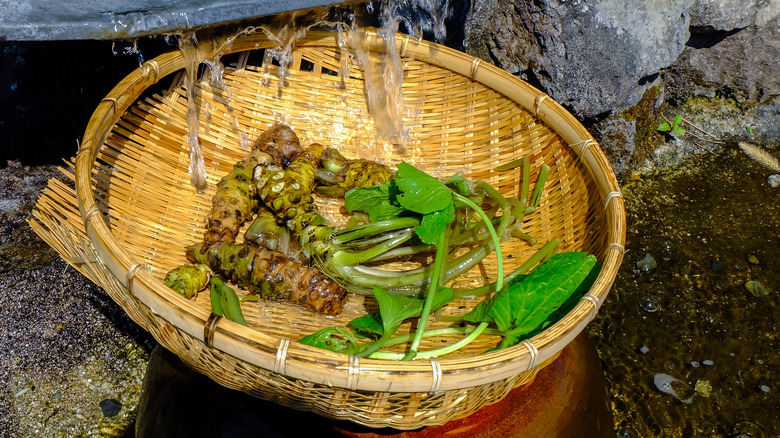What Fake Wasabi Is Actually Made Of?
Do you love wasabi? The potency of the flavor and the sensation are magnificent, whether you're adding it while chowing down on homemade smoked salmon sushi rolls or eating it with raw otoro from bluefin tuna at the fanciest Japanese restaurant. There's nothing quite like that almighty blast of heat followed by the salty taste of soy sauce and the velvety texture of some yellowfin tuna sashimi.
But are you eating real wasabi? Aside from upmarket eateries, the odds are that the green paste you know and love is actually fake wasabi. This means that it has little, if any, wasabi in it at all. If you're wondering what fake wasabi is actually made of, then you're about to find out. Not only that, but we'll also explore what real wasabi is, and how it looks and tastes different. You can learn how to make your own wasabi — and your own fake wasabi, too — and how to use both in cooking beyond a condiment. And before you throw your fake wasabi in the garbage or demand authentic wasabi at your local mom-and-pop Japanese shop, discover why the fake stuff is so commonplace and why so many restaurants are serving it.
Wasabi is made from a specific plant
Unless you're seriously into making Japanese food or have eaten at some pretty quality sushi places, then you might not know much about wasabi. You mightn't know much more than it's that potent green paste served with soy sauce that's fabulous with spicy tuna sushi rolls. Before we get into what fake wasabi is, let's take a look at real wasabi.
Wasabia japonica is the plant used to make wasabi. It's part of the brassica plant family, which means that it's related to plenty of other vegetables you know such as kale and Brussels sprouts. Native to Japan, wasabi has been written about for over 1,200 years and was first used for medicinal purposes. A couple hundred years after that, wasabi became part of Japanese cuisine. In more modern times, wasabi is grown in different parts of the world, including the U.S., although the plant is limited to a few producers here. While you can eat the leaves of the plant, it's the grated stem that creates wasabi paste. And unlike those fake wasabi products on so many shelves, the flavor of real wasabi only has about 15 minutes of fame when it's at its best.
You're probably eating fake wasabi
Did you know that the vast majority of restaurants in the U.S. — we're talking an estimated 95% – serve fake wasabi? So you can imagine then when you've bought it at the store or at a takeout that this number is going to be pretty high, too. The question, then, is not whether you've eaten fake wasabi, but whether you've ever eaten wasabi at all. The reality is that fake wasabi is the only wasabi you might know.
If this is news to you, then you're probably wondering what that green paste at the side of your cucumber rolls is made out of. In all likelihood, it's going to be made out of horseradish, which is part of the same plant family as wasabi. Horseradish is white, and so aside from some mustard being added, it's quite often food coloring that gives fake wasabi its green hue. Before you get hot under the collar and feel like you've been duped, consider why fake wasabi is so prevalent compared with the real thing. You can add some fake wasabi to our baked salmon sushi, which isn't officially sushi because it's not made with raw fish. Otherwise, you might have to go without that spicy hit altogether. Now that you know, you can seek out real wasabi if you like, or at least a product that's made using real wasabi. If you're happy eating the fake condiment, then know that you're not alone.
Fake wasabi tastes hotter
You might be surprised to learn that fake wasabi often tastes hotter than actual wasabi. If you're used to that, there's nothing to say that you might prefer it, and there's no shame. Although if you love your Japanese food, then it's worth trying actual wasabi, even if you're not grating it fresh yourself. Have you ever put too much fake wasabi on a California roll and popped it in your mouth whole with the help of some chopsticks? If so, you will have definitely felt the burn and grabbed for your iced green tea to cool yourself down.
The taste of the horseradish in fake wasabi can be knock-your-socks-off powerful. However, wasabi has a more multilayered taste. It still delivers a kick, but there are sweet notes, too. It tastes fresher and herby with a less intense heat. Some fake wasabi brands do contain some genuine wasabi. However, the percentages are usually pretty low, between 1%-3%, according to some estimates. Both wasabi and fake wasabi are packed with allyl isothiocyanate, which creates a bitter flavor that's also hot. You don't just taste it, as you'll know if you've ever breathed in while near some and felt suddenly wide awake. Wasabi pairs well with sushi-grade raw fish because it cuts across the fattiness. The flavors should balance, and this means only adding a small amount of wasabi or fake wasabi to each bite.
Real and fake wasabi look different
Real wasabi and fake wasabi can look similar at first glance. After all, they're both a fairly bright green color. But you don't have to be an expert to spot the difference. Fake wasabi often looks like a lurid green paste. It's extremely smooth, and if you look closely, it won't have any bits in it.
Fake wasabi can sometimes have the consistency and texture of putty. If you can imagine picking it up and molding it into a shape, then it's likely not from the wasabi plant. Real wasabi is grated, and it should look that way. You're not going to see big, grated pieces. It'll look a bit more like a puree, like minced ginger or garlic. It should look pulpy and a little rough. If you're squeezing wasabi out of a sachet, then even if it's got some real wasabi in the mix, it's likely going to be fake. Unless you've eaten at a fancy Japanese restaurant, you might never have seen wasabi and only ever have tasted the fake stuff. A big giveaway with real wasabi is that it has a grainy texture, and it could be a little paler in color, although the vibrancy of both wasabi and fake wasabi does vary quite a bit, so you can't judge based on color alone.
Wasabi is difficult to cultivate
While fake wasabi might be mass-produced, growing the wasabi plant on a grand scale isn't so easy. The other plants and veggies that wasabi is related to, such as horseradish, aren't anywhere near as tricky to cultivate. The wasabi plants thrive by the side of flowing streams in Japan, where they're kept hydrated, and the low amount of sunlight and limited range in temperatures are well-suited for growth. Trying to create just the right conditions for the plant can be a challenge. The plant does well in rocky soils, but it is fragile if the nutrients are not right. Meanwhile, humidity and the wrong temperature lower the plant's chances of survival. There's way more involved with wasabi compared with some sturdier crops, and growers have to adapt the conditions as wasabi isn't so hardy.
Even when the plant is happily growing, there are all sorts of risk factors, from pests to disease, that make cultivation a perilous journey. If the wasabi plant survives, then it can take a couple of years at least before a plant is ready to harvest. And when it is ready, it is often harvested only by hand. Once out of the ground, the stem that's used to make wasabi needs to be separated from the rest of the plant. These planting, growing, harvesting, and prepping processes, along with the risk factors, pump up the price.
Fake wasabi exists because real wasabi is expensive
One of the reasons, if not the main reason, that fake wasabi exists is that real wasabi is pricey. And one of the reasons it's expensive is that it's not so plentiful. That's because it's not easy to grow on a large scale. Fake wasabi, on the other hand, is made from ingredients that aren't as challenging to source and are way more affordable. The wasabi plant may be related to cabbage and broccoli, but it's certainly not in the same price range.
If you were being served real wasabi in your grab-and-go sushi takeout, it would undoubtedly cost a lot more. However, at a top-quality Japanese restaurant, you're not going to expect to be served horseradish that's green. In June 2022, it was reported that the price of wasabi stems was $396 per kilogram. Of course, there're other wasabi products and even fake wasabi available at a fraction of the cost. If you just want a hot, nasal-blasting bite of sashimi with a drop of soy sauce, then you might decide that real wasabi isn't worth the price. Of course, purists would no doubt balk at the suggestion. Perhaps it's just a case of thinking that instead of the wasabi you usually eat being fake, think of it as just hot horseradish instead. In other words, think of it as different rather than fake, and seek out some real wasabi when you feel like it.
Wasabi is made from a stem
The wasabi plant is a little strange looking. It has a long, knobbly stem, thick stalks, and lily-pad-style leaves that create shade over the rest of the plant. At certain times of the year, the plant also blossoms with pretty white flowers. If you're wondering which parts you can eat, then the answer is simple: all of it, including the flowers. They will all have a taste of wasabi flavor. However, the wasabi that you serve with sushi comes from the stem.
While this part of the plant does indeed look like a root, it does peak out above ground when the plant's growing. The color can really vary too, ranging from milky green to a darker one. At the top, just below the stalks is where the stem is the greenest. And there's often a purple coloring throughout the stem as well. Once this part of the plant is cut, you can make wasabi. Only cut it when you're ready to make it though, so that you keep the pungency of the plant from waning.
Wasabi is more than a condiment
It's not just sushi and sashimi that are perfect with a dab of wasabi on the side. Tempura is also a perfect snack that pairs well with a little kick, alongside soy sauce. If you've ever mixed wasabi with soy sauce at the table, then you're not alone. However, according to plenty of Japanese culinary experts, this is a no-no. Instead, you're supposed to add a little wasabi to your food first and then dip the food into the soy sauce. Beyond this, you should know that wasabi is more than a condiment.
Mix it with mayo to tone down the heat, and make a creamy dip. It's good with grilled shrimp, and it's delicious in sandwiches too. There's no reason you can't venture outside Japanese cuisine. If you like making your own nigiri, then add a touch of wasabi between the piece of fish and the rice. Give salads an Asian twist with a wasabi vinaigrette. Just mix wasabi with rice vinegar. Try it with Sunomono. If you don't have rice vinegar, then use apple cider vinegar instead. Could you add wasabi to soups, stews, and casseroles? What about mixing some in when you make our onigiri rice balls? Or give soba noodles a flavor hit with some wasabi on the side. You can even roast peanuts with wasabi or use it as a marinade.
Wasabi is made using a sharkskin grater
If you're looking for a gift for home chefs who seem to have just about every gadget there is, then check whether they've got a wasabi grater. Or maybe you're a sushi fan and want to treat yourself. It's a specific bit of kitchen kit, called an oroshi, and it's pretty different from your standard box grater. The wasabi root has to be grated extremely fine to get that mushy texture. A microplane grater might be fine enough for ginger and lemon zest, but it's not going to work with the tough wasabi stem.
Wasabi graters are actually made out of sharkskin that's attached to a board. This is the traditional way to make wasabi, and it's still the way chefs who specialize in Japanese cuisine do it today. The end of the stem is cut off so that the surface is exposed. You rub this against the sharkskin grater in much the same way as you might do with a garlic grater plate. Rather than moving the wasabi up and down, you rub it in a circular motion. The sharkskin grater can become part of the theatrics of a dinner party, with wasabi grated at the table.
Make your own real or fake wasabi
If you've got a fresh wasabi rhizome and a specialty grater, then you don't need anything else to make the real-deal stuff. When you grate it, the mushy stem will be soft enough to serve as it is without anything added. You can also make it with some wasabi powder. It's simple and less expensive, for sure, this way. Just mix equal parts powder with cold water. If you want a runnier consistency, then just add a touch more water, or less if you want it a little stiffer.
If you're grating wasabi fresh, then you want to leave it until you're literally almost ready to serve it up. Since you're making the effort, you want the full essence of the flavor and the power of the plant to be at its best. If your wasabi is more than a quarter of an hour old, then it'll start to be past its prime. To make fake wasabi, mix grated horseradish with a quarter of the amount of Chinese mustard paste. Add a little soy sauce and vinegar, and you can also add an anchovy as long as it's chopped up. You could also use fresh horseradish. Other alternatives to wasabi might be English mustard or Chinese mustard.
You can buy real wasabi in the U.S.
It isn't like you can pop down to your local store and grab some fresh wasabi roots, unless your store just happens to be an Asian grocery, of course. If you're determined to source the stems, then an online search is your best bet. In the U.S., Pacific Coast Wasabi in California and Frog Eyes Wasabi Farm in Oregon cultivate the plants. If you store the stem correctly, it'll last a month. Keep it in an airtight container in the fridge, or keep the end you've used in water in the fridge and change this water out every few days. You can wrap the rest of the root in muslin. Or keep it in a plastic bag with a damp kitchen towel inside.
Easier to source in the U.S. is powdered wasabi. It might not be as high-end as the fresh plant, but it's a good alternative as it lasts longer and it's way more affordable. Unless you're serving top-notch sashimi, you might not feel there's a good enough reason to grate a wasabi stem. A third option is to buy wasabi paste. As long as you keep this in the fridge, then it'll last. With a few choices available that do contain some wasabi at least, you might want to banish dipping anything in fake wasabi. That's unless you prefer the taste, of course! Check powders and pastes to make sure they're made from real wasabi and not horseradish instead.
Both real and fake wasabi have health benefits
Wasabi is purported to have antibacterial and anti-inflammatory properties. It could be that wasabi might protect against certain bacteria that cause food poisoning. Since it's traditional to eat wasabi with raw fish, then the wasabi in your sushi and sashami might be about more than taste. It could protect against bacteria in the fish. Research is ongoing regarding how wasabi could guard against a bacteria that causes peptic ulcers. Beyond this, wasabi may play a positive role in guarding against cancer as well as promoting fat loss.
The word "fake" might suggest that imitation wasabi doesn't have any health benefits at all. Since a lot of fake wasabi is made from horseradish, though, this isn't the case. In fact, horseradish is also anti-inflammatory and antibacterial. However, fake wasabi could also contain soy, which isn't great if you've got an intolerance or allergy. Fake wasabi can also be high in sodium even in a small serving. What you'll definitely know if you've eaten either is that they certainly clear out the airways. Researchers are looking at how horseradish may help fight sinus infections and certain respiratory issues.
Grow your own wasabi
If you've grown your own windowsill veggies and herbs, then you might want to branch out and grow your own wasabi. It's true that commercial cultivation isn't without its difficulties, but that doesn't mean to say that you can't grow a few wasabi plants at home. In an interview posted at The Wasabi Store, Jennifer Bloeser, co-founder of Oregon Coast Wasabi, offers a few tips on looking after wasabi plants in your garden.
The key points are to grow them in 1-2 gallon pots, and make sure they're shaded from direct sunlight. Keep the soil nice and wet, but don't leave the plants sitting in water. While a few days of high temperatures is fine, if it's hotter than 80 degrees Fahrenheit for much longer than a few days, you need to bring the pots indoors to cool off. Similarly, anything lower than 32 degrees Fahrenheit is too cold. However, it's advised that you purchase an existing plant rather than seeds as not all wasabi seeds are real. It could take a couple of years before your plants are ready to harvest. That gives you plenty of time to master the art of making sushi to go with your wasabi!
